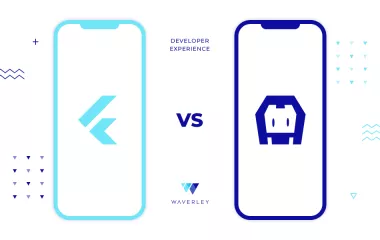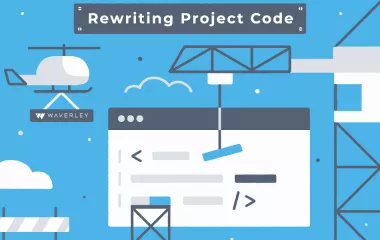Why Use Flutter: Pros and Cons of Flutter App Development
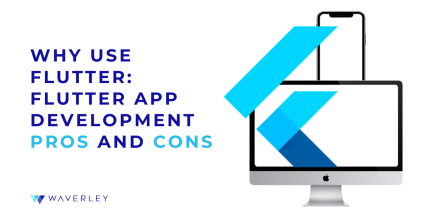
Contents
Flutter is one of the most dynamically evolving tools for creating cross-platform applications. If you came across this article by googling Flutter, then you’re probably wondering what all the buzz is about and whether Flutter is worth a try.
This article will help you better understand what Flutter is and why to use Flutter for app development. The information presented includes an overview of the reasons to use Flutter, while the Flutter pros and cons will explain why many engineers choose Flutter over its competition. In short, it answers the question why you should choose Flutter and what benefits you will get when working with this tool.
What is Flutter?
Flutter is an open-source UI framework developed by Google that allows developers to build native-quality mobile, web, and desktop applications from a single codebase. Flutter is a valuable modern tool used to create stunning cross-platform applications that render native code on each device and OS. Flutter is compatible with Android, iOS, Linux, macOs, Windows, etc.
There are two key components of Flutter:
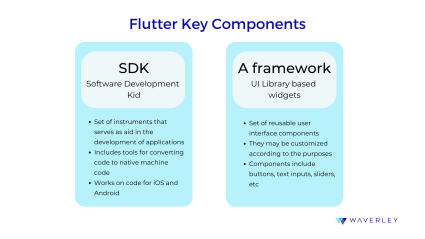
Flutter Architecture overview
The Flutter tool incorporates three architectural layers:
- Framework: The most visible part of the Flutter technology. It is based on the Dart programming language.
- Engine: Written in C/C++, this layer provides graphics, accessibility support, text layout and other essential APIs.
- Embedder: A platform specific embedder is used to help the Flutter App to run on any OS.

How Cross-platform Development Works with Flutter
Flutter is a multiplatform technology that maximizes code exchange and ensures interoperability with different platforms. The developer creates an original code that becomes exclusive to each platform instead of creating native solutions.
Flutter helps companies save their development budgets, as there’s no need to hire native app developers, you just need a professional Flutter engineer creating the functionality, and the tool will do the rest. It is compatible with mobile platforms (iOS and Android), Desktop platforms (Windows, Linux, MacOS), as well as the web.
As a result, the shared code approach is used to quickly develop software of any complexity and makes Flutter one of the best known tools for fast and cost-efficient MVP development.
Why Use Flutter: Pros and cons
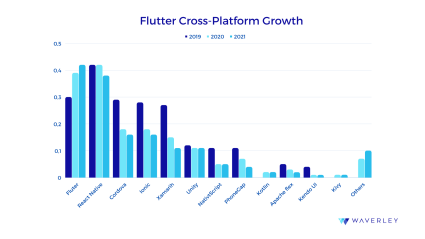
Ever since Flutter came out, it has drawn a large and engaged community of developers. One of the benefits of Flutter is that it is simple. This means widgets can have changes or are subject to customization with ease. Moreover, the Dart programming language and Flutter are easy to learn and start creating with, so that there never will be a shortage of specialists, any software engineer can easily and quickly switch if needed. One of Flutter’s most appealing elements is UI widgets that adhere to important web application design standards.
About Widgets
Widgets are components that appear on a screen of the Flutter app. The choice and arrangement of the widgets used to create an application is important. It has a significant impact on how the screen will look like.
| Categories | Description |
|---|---|
| Accessibility | Widgets that make applications more accessible |
| Animation and motions | Widgets that add more animation to other widgets |
| Assets image and icon | Widgets in charge of assets like display images and show icons |
| Async | Widgets that provide async functionality in the Flutter app |
| Basics | Widgets that are essential for the Flutter app development |
| Cupertino | Widgets designed for iOS apps |
| Input | Widgets that provide input functionality in the Flutter app |
| Interaction Models | Widgets that manage touch events and guide users to different views in the app |
| Layout | Widgets as a support system for other widgets to be placed on the screen when needed |
| Material Components | Widgets that follow material design guidelines by Google |
| Painting and Effects | Widgets that apply visual changes to their child widgets avoiding any layout or shape changes |
| Scrolling | Widgets that help other widgets scroll by default |
| Styling | Widgets in charge of the theme, size and responsiveness of the app |
| Text | Widgets that display and style the text |
A contemporary framework is used to create Flutter widgets. Essentially they serve as building blocks for your application interface. They provide descriptions of how their views should appear given their settings and current state.
Widget categorization and functionality are visible in the chart above. It shows the advantages of having widgets lead to the simplicity with which the Flutter framework can be used.
But, why Flutter? This next section will explain other reasons why you should choose Flutter over other cross-platform app development tools such as React Native, Cordova, etc. Here’s a short list of the advantages of flutter app development as well as the disadvantages you should be aware of to make Flutter work for you.
Want expert guidance on Flutter app development?
Advantages of Flutter
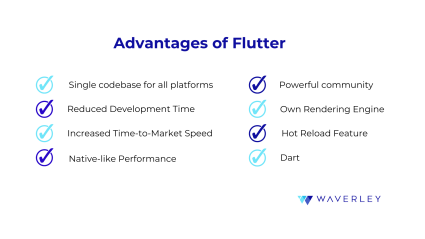
- Single codebase for all platforms: There is no need to create separate code bases when working on iOS and Android devices. Flutter allows developers to build a single codebase and use it for several platforms such as the web, desktop and mobile. This results in quicker app launch and is cost effective.
- Reduced Development Time: The requirements for Flutter application development are much lower. So the positive outcome is that there are no additional maintenance charges. Flutter makes it possible to create larger apps that use unique features.
- Increased Time-to-Market Speed: The Flutter development framework is more responsive than others. This tool’s quick time-to-market is one of its key advantages. It is mostly difficult to predict if iOS or Android versions will be able to provide a product on time. This is where Flutter plays its role, as it allows cross-platform usage.
- Native-like Performance: This is one of the Flutter advantages that stands out the most. Flutter works with Skia, a graphics engine which enables quick and well optimized development. It also is indistinguishable from native apps as it doesn’t rely on interpreters or intermediary code representations.
- Powerful community: According to statista, Flutter has become one of the most popular frameworks and a first choice by developers globally. Over 40 percent of software developers have chosen Flutter over the course of the last three years. The following chart shows the growing interest in Flutter in comparison with other cross-platform app tools.
- Own Rendering Engine: The problem with some cross-platform solutions is that they are very similar on iOS and Android. This is why Flutter is the best option, because it consists of packages that contain a set of unique widgets for both operating systems.
- Hot Reload Feature: The ability to hot reload is one of the main benefits of using Flutter. This is for effective cross-platform development so it can complement the nature of Flutter. This feature’s function speeds up application development.
- Flutter’s Safety. Null-safety is supported on the syntax level. Flutter’s UI code is single-threaded, and computational threads are executed in isolated sandboxes which means no shared or unsafe resources at all.
- Dart: Developers’ reason to choose Flutter is because of the Dart programming language Flutter is based on. It has features that make it stand out from other languages:
- Ahead Of Time (AOT) compiler which makes Flutter Widgets customizable and a quick startup possible.
- Just In Time (JIT) compiler, since it makes it possible to optimize a code while it is running.
Dart compiles into highly optimized JavaScript on web platforms. The next step is WebAssembly for Web which will provide much better execution/animation speed compared with other platforms. These are only some of the features that make Dart count as an advantage of using Flutter for development purposes.
- Excellent documentation and community support: Flutter benefits from extensive documentation and a vibrant community. Developers can find resources, tutorials, and support easily, making it easier to learn and troubleshoot any issues they may encounter.
- Strong industry adoption: Flutter has gained significant traction and is used by well-known companies such as Google, Alibaba, Tencent, and more. Its growing popularity ensures ongoing support and updates from both Google and the Flutter community.
- Material Design and Cupertino widgets: Flutter provides out-of-the-box support for both Material Design (Android) and Cupertino (iOS) widget sets. This ensures that the UI looks native on both platforms, creating a consistent and familiar user experience.
Flutter Disadvantages
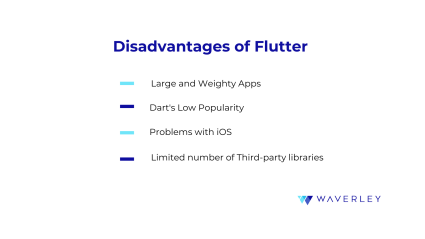
No tool is perfect and Flutter is no exception. Flutter itself can have a few drawbacks because it is still a new tool for certain applications. Let’s not forget that it was created only a couple years ago, so the community is still testing its limitations and identifying compatibility issues on various platforms. The fact that it is meant to work with numerous platforms leveraging their peculiarities makes it more difficult and time-consuming to make it work with everyone, but at Waverley we believe the tool will get there eventually.
- Large and Weighty Apps: A loophole that can’t be dismissed is the size of the large size of the applications under development. Software developers working with this toolkit may find it difficult to work with large files. This can cause them to choose a lighter alternative.
- Dart’s low popularity: It’s a fact that Dart is a reliable programming language since it is fast. It is also true that developers are starting to make it an option. Yet, Dart is still not able to compete with other top programming languages such as java, Kotlin, etc.
- Problems with iOS: The Flutter framework works well on both Android and iOS. However, Flutter was developed by Google, which gives Android apps a key advantage. It isn’t considered a major issue, but it is something to consider in case some problems may be present in the future.
- Limited number of third-party libraries: Flutter being relatively cannot be compared to native programming languages. Developers still need to spend more time building as many libraries as possible.
As a new toolkit it is still adapting to changes and improvements. But hopefully we now gave you a better understanding why using Flutter is a fast and cost-efficient alternative to native app development.
For in-depth insights, read our article on How to hire Flutter developers.
FlutterFlow – A Game Changer in MVP App Creation
The Flutter team has just rolled out a new tool that’s going to change the way businesses prototype their software. Flutterflow is basically a no-code platform for creating beautiful, fully functional MVPs, leveraging the best of Flutter – speed, security, and ease. It works as a constructor, allowing users to build functional apps by adding widgets with the needed functionality that have been pre-designed. Current functionality available includes:
- Chats
- Push notifications
- Animations
- Dark/light mode
It is collaborative, meaning you can create your apps together with teammates by commenting and using drag-n-drop from a library of 140+ available components. You can easily integrate it with third-party tools, such as the Firebase Content Manager, export beautiful clean code which can be expanded with custom elements and rendered into native code on various platforms.
Flutterflow will allow businesses to quickly create simple MVP in an easy way, use these MVPs to get investments and then pass them to the development team to expand and build functionality on top to turn the MVP into a full-scale product. The development team, on the other hand, will receive a tool to quickly jumpstart projects and conduct excellent product demos.
Apps developed on Flutter
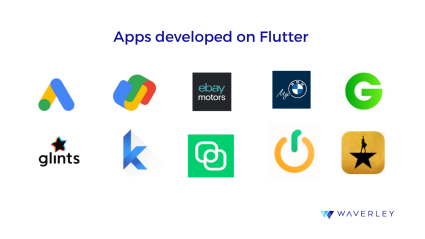
We just recently mentioned the benefits of Flutter app development. Good thing about Flutter is that it is faster, it allows you to create apps by using a unique code for different platforms, which means:
- Faster results
- Fewer developers needed
- Lower development costs
- Faster rendering time
- Ability to create complex 3d animations that work faster
- High-quality platform-specific UI
- Many platforms supported
As proof of Flutter’s growing list of advantages, more and more companies are using it for their mission-critical apps and enterprise mobility. Companies from startup businesses to major and well-known giants like Google and Ebay rely on Flutter to deliver seamless experiences to their customers. Right below is a list of the top 10 popular apps you had no idea were created using Flutter.
Established companies using Flutter
Google Ads
Google’s initiative for online advertising is known as Google Ads. It helps you create online advertisements for people searching for goods and services provided by a company. Flutter development has enabled the independence and intelligence of the application. It provides improved insights and quicker ad alerts.
The application features campaign data, real-time budget, live notifications, keyword tweaking and the ability to get in touch with a Google expert.
Google Pay
Online transactions are becoming more popular each day. That is why Google Pay comes in handy. It is a digital wallet and payment app by Google that allows Android and iOS users to make purchases online as well as in stores. Flutter fit perfectly into this app since the company needed to improve its functionality and environment.
eBay Motors
Just like eBay, the new eBay Motors application serves as a buy or sell platform. It is one of the largest marketplaces for people to search, buy or sell motor vehicles. As in most apps, Flutter serves as a developer-friendly and in time a user-friendly framework. It wasn’t any different for the eBay motors app as it improved its features. Flutter was tested for weak points, however, the app development was a success as the framework was able to complete all of the firms’ tasks efficiently.
My BMW
Another automotive app that was built using Flutter is the BMW App. This platform works both on iOS and Android, it is an application used by BMW drivers to find parking spaces, POIs, location sharing, etc. The Flutter framework helped improve the application’s functionality and it made sure it would have a user-friendly and lightweight interface.
Groupon
For the best deals and coupons, users turn to the Groupon application. It offers deals and discount coupons for different brands. The application can be used from a customer standpoint or from a merchant viewpoint. The great functionality of the application is due to the implementation of Flutter. The app works wonderfully as its user interface is light and easy to use.
Startup companies using Flutter for their App development
Glints
When looking for a job, Glints is one of the to go apps. The application was developed with the Flutter framework and as a result it has an improved and simpler interface. The accessibility of the application has made it more appealing to users.
KlasterMe
Speaking about social media applications, KlasterMe is a social media app for content sharing. Thanks to developers using Flutter, the KlasterMe interface streamlines publishing and produces visually appealing results. Although the app is merely a work in progress, Flutter is making its wonders for it to be a user-friendly app.
Fuse
A creative Flutter application that allows users to split expenses with friends and family members. The app keeps track of the expenses done by a group of people and deducts the money from their bank accounts. Flutter worked wonders. It helped in the creation of the app by creating a safe and easy to use platform. Users can easily save their bank card information, scan their receipts and much more with no extra fees. Additionally, Flutter made it available for the app to be downloaded by Android and iOS users.
Fastic
As a health software, Fastic offers users individualized options for nutrition, sleep and other health aspects. This app was developed to help Flutter to provide customers with cutting edge features such as reminders, real-time health monitoring, sleep schedules , etc.
Hamilton Musical App
The Broadway theatrical business, Hamilton has its own application. It works as a mobile app that enables users to be up to date in the latest music related events, to buy merchandise, etc. Developers used Flutter for its quick functionality and to offer unique features on a Karaoke system. The app enables users to sing their favorite songs when using the app.
Our Experience with Flutter
Flutter is growing in popularity despite being a relatively new framework. Waverley has been receiving multiple requests for Flutter app development services across industries. Below are just a few examples of the Flutter projects we helped deliver.
- The team helped our client with the project Holu Hou. The project consists of the production of sustainable energy in the Hawaiian area. Our technical team created Flutter-based Android and iOS apps. Additionally, our team worked on the development of a web interface that supports AWS. The software enables users in the Hawaiian market to control their solar energy panels and examine statistics of their solar energy usage.
- Waverley helped with the development of an app for smartphones by the Yale Center for Emotional Intelligence. The app goes by the name Mood Meter Matrix, it is a component of a larger initiative to produce an emotional intelligence teaching tool, which can be used to measure and increase emotional awareness. This app was developed using the Flutter framework for a more improved accessibility.
To find out more about Waverley’s experience with Flutter, please fill in the form below and request an extended portfolio.
So Why Try Flutter?
We hope that now you have a better understanding of what Flutter app development is and why it can be beneficial for your business. The Flutter framework is still a fairly new tool developers choose for app development. Yet, it has become a first choice for many, conquering the hearts of software engineers at an unprecedented rate. Flutter is more accessible than its nearest competitors, it is cost-effective and has a user-friendly interface. In our opinion, Flutter is worth giving it a go, and our team will be monitoring its growth and progress with huge interest.
At Waverley, our engineers have been delivering Flutter solutions that brought tangible benefits to businesses worldwide. We have offered solutions for business processes improvement and created modern user-friendly functionality using Flutter. Our development team is ready to help your business investigate whether this tool is a great fit to solve your business needs.
If you would like to discuss the advantages of using Flutter or if you need technical assistance, please use the form below to contact us.
Schedule a free consultation for your next Flutter app
FAQ
What is Flutter used for?
Flutter is used for building cross-platform applications. Since it operates within a single codebase and renders into native code on each platform, Flutter engineers can create native-like applications faster and with lower development costs. Flutter apps comply with iOS, Android, Windows, MacOS and other platforms.
What is Flutter?
Flutter is an open-source tool created by Google that allows creating functional, secure and very fast cross-platform applications (iOS, Android, MacOS, etc.).
Is Flutter better than React Native?
The answer would depend on your requirements, but overall Flutter is faster, more modern and cost-efficient. It is better suited for developing MVPs, since it requires less time for the optimization of native platform characteristics than React Native. In addition, on average, the rates for Flutter engineers are lower globally than those of React Native engineers.
Should I use Flutter for app development?
Yes, Flutter is definitely worth giving a try. It is a modern, fast, secure and easy way to develop cross-platform applications, it is well-supported, scalable, has a vast engineering community behind it and, in our opinion, a lot of potential.
What is FlutterFlow?
FlutterFlow is a recent tool created by the Flutter team allowing to create cross-platform MVP applications fast and with no coding required. It has a flexible widget structure, which users can use to create functional app interfaces fast and then export clean ready-to-use code which can be expanded into full-scale applications.


